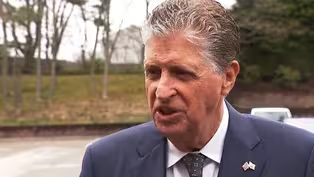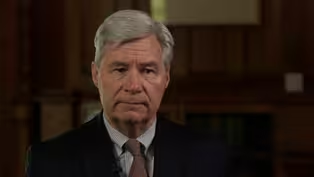
Uprooted
Clip: Season 6 Episode 20 | 10m 58sVideo has Closed Captions
A Rhode Island artist transforms the work of nature into a work of art.
Rhode Island PBS Weekly heads into the woods of southern Rhode Island to meet an artist who was uprooted from her homeland. Ana Flores, a Cuban-born painter and sculptor, has spent decades turning materials from nature into works of art.
Problems playing video? | Closed Captioning Feedback
Problems playing video? | Closed Captioning Feedback
Rhode Island PBS Weekly is a local public television program presented by Ocean State Media

Uprooted
Clip: Season 6 Episode 20 | 10m 58sVideo has Closed Captions
Rhode Island PBS Weekly heads into the woods of southern Rhode Island to meet an artist who was uprooted from her homeland. Ana Flores, a Cuban-born painter and sculptor, has spent decades turning materials from nature into works of art.
Problems playing video? | Closed Captioning Feedback
How to Watch Rhode Island PBS Weekly
Rhode Island PBS Weekly is available to stream on pbs.org and the free PBS App, available on iPhone, Apple TV, Android TV, Android smartphones, Amazon Fire TV, Amazon Fire Tablet, Roku, Samsung Smart TV, and Vizio.
Providing Support for PBS.org
Learn Moreabout PBS online sponsorship- [Ana] This is where the glaciers ended 10,000 years ago and dropped a lot of stone and rubble and boulders.
So of course you'll see a lot of stone walls.
Some of these lots around here were used for wood by the colonials, so it's kind of a scrubby forest landscape, but it holds all kinds of histories here.
- [Michelle] Artist Ana Flores is fascinated by the stories the land holds.
It's one of the reasons she likes to start her days by going for a walk in the forest next to her home in Charlestown.
This stretch of southern Rhode Island has a complicated history.
- It's the land of the Narragansetts and they're still very present.
It's also a place, it's had a history that is very connected to the Caribbean because Rhode Island was part of the slave trade, the New England slave trade in this area.
Charlestown had one of the slave plantations in the area.
- [Michelle] For Flores, the land isn't simply a muse, it's also an extension of her studio.
(branches rustling) She's searching for materials she can incorporate into her artwork.
- I do a lot of branches.
(Ana chuckling) A lot of wood comes in because all kinds of forms of wood, stones and manmade objects that get left behind and rusted.
- How would you describe the type of artist that you are?
- I call myself an ecological artist 'cause I very much work with a relationship with the natural world.
And I also call myself an interdisciplinary artist 'cause I use numerous medias.
I'm a sculptor, painter, writer.
(machine whirring) - [Michelle] Flores's work has been featured in exhibits around the world.
Her pieces, she says, are rooted in identity, place, and discovery of place.
Her work's been described as evocative and at times provocative.
- One of the first larger pieces that I made was a piece called "Gaia," and it was made out of a root system that kind of became almost like an earth womb.
You know, it was like the earth giving birth.
- [Michelle] Flores recalls the piece being censored in the late nineties at a university library.
It was moved to a less visible gallery.
- I had a discussion eventually with the dean of the library and it was quite clear it was censorship.
I mean, he just didn't want it in there.
He said, "Too many people are stopping and talking."
(machine screeching) - [Michelle] She ended up removing the sculpture.
It went on to be displayed at the National Museum of Women in the Arts in Washington DC.
(soft music) For Flores, "Gaia" represented how humans have abused the environment.
She's not afraid to make a statement through her work.
It's a privilege she does not take for granted.
She was six when she left Cuba with her family in the early 1960s as a political refugee.
Fidel Castro's promise of a free Cuba vanished.
- [Reporter] Castro gloated over his victory and told the world that Cuba was now a socialist nation.
- What memories did you have of Cuba as a little girl?
- Going to the shore with my nanny and fishing and swimming, it was like paradise.
And then we left that because of the revolution, my parents didn't wanna live under communist rule.
- [Reporter] Where Castro has admitted his communist sympathies and where communist propaganda is being manufactured.
- [Michelle] Flores seen here as a baby in Havana, ended up moving to Connecticut with her family.
She later graduated from the Rhode Island School of Design where she met her husband.
(upbeat music) She returned to Cuba in 2002, her first time back, since leaving the island 40 years earlier.
She found a British bicycling group that was doing tours there and spent three weeks taking in the sites.
- It was a wonderful way to be in the landscape and really meeting Cubans, you know, because you were coming in on bicycles.
You weren't just these fancy tourists.
And I just, I felt so Cuban.
(Ana laughing) It's a funny thing to say.
It was like this whole suitcase of my life and my memories had been put away for a long time.
And that trip brought it out.
(upbeat music) - [Michelle] And it inspired Flores to create the "Cuba Journal," a multimedia installation featuring her homeland.
It was displayed throughout the United States for several years.
It included these toy sized sculptures made from driftwood and recycled materials showing Cubans dancing, recalling the joy she witnessed while visiting her uncle and cousin, Rosita, on the island.
- She put on this Cuban music and they began to twirl around this small apartment.
Rosita looked at me and said, "Castro can't take this from us."
And I thought, that captures it all.
That's that Cuban resilience.
(car vrooming) - [Michelle] Resilience in the midst of suffering.
Flores also designed a larger than life puppet of Castro made from paper mache and mosquito netting.
Its presence threatening the small wooden figurines of locals below it.
Flores used theatrical lights to create shadows.
- Cuba is a small island, but it's had such a large political history in the story of, you know, the western world in the last, you know, a hundred plus years.
And so in many ways it was, you know, the shadow of something can be much larger than the thing itself.
(leaves rustling) - [Michelle] Flores says, traveling to Cuba made her feel more rooted in Rhode Island.
She spent much of the last two decades devoted to creating work that helps communities connect with their landscapes.
(water rushing) - We do have an environmental problem.
We're not taking care of the planet and of the places we live in, partly because of ignorance.
We don't understand how our behavior can affect it.
You can't just give people data about that.
They have to live and care in a kind of tactile, immersive way to understand how what they do matters.
- [Michelle] When Flores became the first artist in residence at the Wood-Pawcatuck Watershed Association, she was tasked with teaching people about watersheds.
She soon found herself carrying around garbage bags and cleaning up the trails.
- As I did that, I would keep saying, "God, how do you make people out here thoughtful and you know, how do you turn slobs into poets?"
- [Michelle] She went on to create her poetry of the Wild Project.
She designs boxes that look like bird houses.
Each one contains a poem and a journal where visitors can jot down their thoughts.
- Every time I go and do a workshop to make these boxes, I tell them what a watershed is.
I bring in an an example of this 3D topo watershed where they can sprinkle water and see that the water falls into certain gullies and it flows down in that direction.
So it became a tactile way to explore what a watershed was.
(camera shutter clicking) - [Michelle] It's a project she's launched across the country.
She hopes it motivates people to slow down and appreciate their environment.
- You can tell people there's gonna be bird watch walks or this or that, and a lot of people won't go hiking, but if you tell them there's a poetry box, a writer they might know wrote something for the box, their children might have been involved in making some of the boxes.
All of a sudden you get this new audience going out walking.
(water rushing) - [Michelle] On this day, she took a stroll through the Canonchet Brook Preserve in Hopkinton with Sarah Windsor, Chair of the Hopkinton Land Trust.
(leaves rustling) Together they searched for a spot to place a poetry box.
(water rushing) - Now what we should do is mark this.
- [Michelle] For Flores, there's nothing quite like seeing her work out in the world.
- You become more aware by doing more walking, more careful observation of what you're doing.
You begin to care more, and then maybe you act in a different way.
(leaves rustling) - [Michelle] An artist with a deep appreciation for the place she calls home after being uprooted from hers as a little girl, - I'm not just one type of artist, I'm only happy if I'm working in a sort of broad spectrum of medium.
I never planned to be this kind of artist.
It was really this place that made me this kind of artist.
Video has Closed Captions
Clip: S6 Ep20 | 3m 5s | The Rhode Island House rejected Governor McKee’s proposal to give cabinet members raises. (3m 5s)
Video has Closed Captions
Clip: S6 Ep20 | 10m 19s | In-depth interview with Senator Sheldon Whitehouse on the state’s loss of funding. (10m 19s)
Providing Support for PBS.org
Learn Moreabout PBS online sponsorship
- News and Public Affairs

Top journalists deliver compelling original analysis of the hour's headlines.

- News and Public Affairs

FRONTLINE is investigative journalism that questions, explains and changes our world.












Support for PBS provided by:
Rhode Island PBS Weekly is a local public television program presented by Ocean State Media

